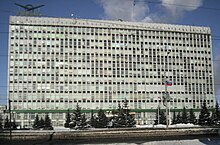UAZ
In response to this threat, the government of Joseph Stalin ordered the evacuation of strategically crucial industrial centers to the East.
The town, already a nascent industrial center with a sufficiently developed infrastructure and a good supply of skilled workers, would be an ideal location for the reconstituted factory.
In 1943, when the prospect of a German victory had become far less likely, it was decided the relocated plant would remain in Ulyanovsk and be separated administratively from ZIS, which would be rebuilt in Moscow from scratch.
[4] UAZ developed a prototype 1.5-tonne truck in 1948, using the ubiquitous 50 hp (37 kW; 51 PS) 2,112 cc (129 cu in) inline four of the Pobeda; this, the UAZ-300, was never built, due to a lack of production capacity.
[6] It was this office, responding to a request from the Red Army, that in 1955 created a forward control van project, codenamed "Forty", on the GAZ-69 chassis.
[6] Its loaded weight was 2.7 tonnes, and it, like all the UAZ-450 series vehicles, was powered by a 62 hp (46 kW; 63 PS) low-compression 2,432 cc (148.4 cu in) inline-four (based on the ubiquitous Pobeda's, but with an 88 mm (3.5 in) bore, rather than 82 mm (3.2 in)), and the Pobeda's three-speed transmission, while the transfer case, drive axles, leaf springs, and drum brakes came from the GAZ-69.
[6] All the UAZ-450 series were capable of disconnecting the front drive axle and of reaching 56 mph (90 km/h), achieving fuel economy of 14 L/100 km (17 mpg‑US; 20 mpg‑imp), and of towing an 850 kg (1,870 lb) trailer.
[6] A two-wheel drive variant of the UAZ-450 was announced on 12 December 1961, with the UAZ-450's 2,300 mm (91 in) wheelbase and engine, as the UAZ-451 (van), UAZ-451D (drop-side pickup), UAZ-451A (ambulance), and UAZ-451B (minibus).
[7] The ambulance spawned a prototype UAZ-452GP with hydropneumatic suspension, to enable it to cross rough ground at high speed, following on the work done by Citroën on the DS19.
[8] In 1966, the UAZ-451s were updated with a 70 hp (52 kW; 71 PS) 2,432 cc (148.4 cu in) inline-four (still based on the Pobeda's), four-speed gearbox, and minor detail changes, plus a stronger chassis (and so higher payload).
The UAZ-469 was not made available to the civilian market until the late 1980s, before which time it was built exclusively for police and military use, as well as heads of agricultural enterprises (kolhozes and sovkhozes).
[15] In 2006, UAZ opened a new control and test section of the main assembly line and presented 4 new cars at the Moscow International Automobile Salon.
A UAZ Patriot support vehicle took part in the 2015 Dakar Rally, crossing the route of 9,295 km through Bolivia, Chile and Peru.
In August the UAZ Patriot received new upgrades, including new paint colors, 18-inch wheels, interiors, frameless wiper blades, etc.
[16] In May 2023, Izvestia reported that UAZ would shortly launch knock down production of vehicles in Cuba, as a result of negotiations between Russian and Cuban enterprises.


